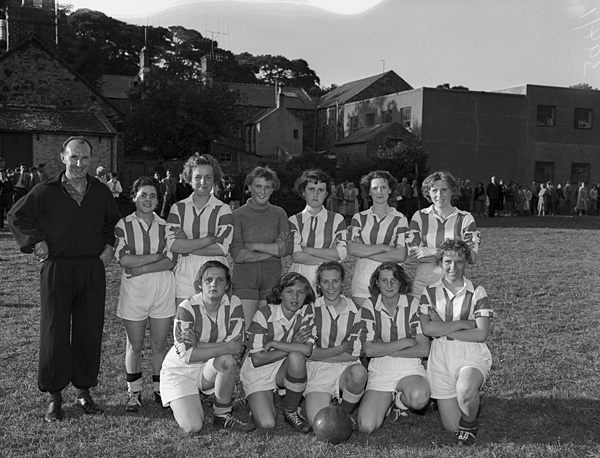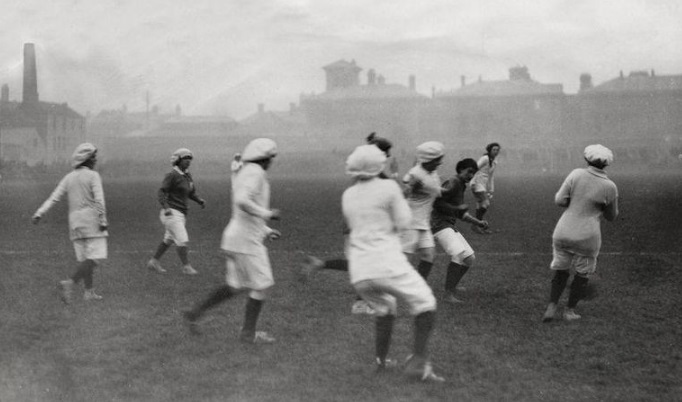 The Women’s World Cup is currently in full swing, so we’re riding on the waves of footy euphoria and using the tournament as a springboard to explore the fascinating and turbulent history of women’s football. This is a great topic for the EFL classroom as a conversation lesson that can be adapted for all language levels, concerning issues of sport, politics and sociology. It also includes lots of vocabulary that will be useful for language learners across many areas.
The Women’s World Cup is currently in full swing, so we’re riding on the waves of footy euphoria and using the tournament as a springboard to explore the fascinating and turbulent history of women’s football. This is a great topic for the EFL classroom as a conversation lesson that can be adapted for all language levels, concerning issues of sport, politics and sociology. It also includes lots of vocabulary that will be useful for language learners across many areas.
How did women’s football go from being hugely popular in the 1920s to being almost unknown in the UK for fifty years? Read on to find out how and why women’s soccer was side-lined – and how it is now experiencing a resurgence to become the fastest growing sport in the world.
The glory days of women’s football
In the early 20th century, women’s football was immensely popular in England. Women’s games often drew bigger crowds than men’s. When the men went to fight in the First World War, the men’s national football league was suspended – and the women’s game took its place. The sport went from strength to strength.
These were the glory days for women’s football. In 1920, the women’s game was at the height of its popularity. 53,000 fans watched the women’s unofficial England team beat St Helens Ladies 4-0 at Everton’s Goodison Park, with thousands more spectators waiting outside.
The FA banned women’s football
However, that all changed when the FA decided to ban women’s football in 1921. This was just as the game was soaring in popularity and despite women playing at the FA grounds for many years previously.
The ban mean that the women’s game was immediately restricted to amateur status, received no money from the FA and no structural support. Women’s teams couldn’t use FA pitches or coaches or other resources.
The FA’s official reason for the ban was that they suddenly thought football was ‘unladylike’ and ‘bad’ for women’s health, especially their ovaries.
The real reason, of course, was simply misogyny. The FA did not want the women’s game to be as popular as – or more popular than – the men’s game, so they suppressed it.
There was also a political motive. They were worried about the potential for social revolution. Working-class women were becoming popular as public figures and could get a powerful voice, so the FA decided they had to be stopped.
However absurd and bizarre the FA’s official explanation about women’s health, their new ruling meant that women had no suitable place to play football and no structural support. So the game went into decline.
Meanwhile, money was pumped into the men’s game and it flourished into the billion-pound industry we know today.
Prejudice against women in sport
The FA’s ban in 1921 also created the idea in the public’s mind that football was somehow ‘unsuitable’ for women, creating the catalyst for generations of prejudice against women in football.
The official ban on women’s football at FA grounds existed for 50 years and women were discouraged from playing football in the UK for all this time.
The ban was only lifted in the 1970s and by then, the discouragement and lack of opportunity to play had affected two generations of women.
It took a long time for old attitudes to change. Even in the 1980s and 1990s, football was rarely offered to girls as a sports option at schools in England. Without women’s football on television, any visible role models or encouragement, many girls never had the opportunity to try the sport.
TV presenter Clare Balding presented a program called ‘When Football Banned Women’ (Channel 4), which explored the infamous FA ban and its terrible repercussions for the women’s game.
Women’s football in the USA and Europe
Interestingly, in the USA where no official ban ever took place, football (or soccer as Americans call it) has never had this restrictive ‘men-only’ reputation. The most popular sports for men when soccer arrived in the US were American football and baseball.
As football (soccer) only arrived in the USA in relatively recent history, it has none of the stifling attitudes that many women and girls have experienced in the UK. America led the way for women’s football with many top female players from Europe moving across the pond to join US teams.
(Idiom: the idiom ‘across the pond’ – the pond is the Atlantic Ocean and in the UK going ‘across the pond’ means going to America)
In England, the Women’s Super League (WSL) is now flourishing with Manchester City, Arsenal, Liverpool and Chelsea particularly successful.
Across Europe, women’s football has grown enormously in just the last 5 years with more investment from top clubs leading to great improvements and new opportunities. In France, the Paris Saint Germain and Lyon women’s teams play at huge venues and with an €8 million budget, Lyon are the best-funded women’s football team in Europe.
![UEFA Women's Champions League - SKN St. Poelten vs Manchester City, Ailura, CC BY-SA 3.0 AT [CC BY-SA 3.0 at (https://creativecommons.org/licenses/by-sa/3.0/at/deed.en)], from Wikimedia Commons Women's Football - Manchester City Women Team Photo](https://www.myenglishlanguage.com/wp-content/uploads/2017/07/manchester-city-women-football.jpg)
4. Manchester City players line up for a team photo. The front players hold a sign highlighting the 2017/2018 UEFA #EqualGame campaign, which championed diversity, inclusion and accessibility
As interest and competition grows, the top clubs of Europe are now starting to put more money and resources into their women’s teams.
Although Germany and Scandinavia have always boasted the top women’s leagues, the WSL (Women’s Super League) in England is attracting lots of new talent and the leagues of France, Spain and Italy are also increasing in power.
Although it will take many years to catch up with the finances of the long-standing men’s game, the top female footballers can now earn large amounts of money.
Women’s soccer is now the fastest growing sport in the world.
As the support, coverage and popularity of women ‘s football rises, the players’ salaries will rise along with it. This means young girls thinking about their future today can see that professional football is a career option for them.
The Women’s Euros 2017 attracted many new fans and a whole new generation of girls has been inspired to start playing football. The Women’s World Cup 2019 tournament also raised the interest level in women’s football with record viewing figures.

The Canadian women’s team await a corner kick – Image source
Questions to ask in a conversation lesson:
- Why do you think the FA banned women’s football?
- How do you think the FA’s ban affected girls’ and women’s attitudes to the sport in the UK?
- And how did the ban affect boys’ and men’s attitudes?
- How would you feel about being banned from playing a sport the whole world enjoyed?
- Why has women’s football not always been popular in the past?
- Why has it has started to become more popular in recent years?
- Where do you think women’s football is headed in the future?
- Why do you think some people want to stop others people from playing a sport? (Control? Fear? Bullying?)
- How can sporting popularity bring power? And revolution?
- Why has America had less of a problem with prejudice in football?
- What position do/would you play on the football pitch? (Goalkeeper, defender, midfielder, forward/striker). Why do you choose that position? Explore positions in our soccer vocabulary page.
- What does it mean to be a good footballer?
- What makes a good team?
- What makes a good football manager?
Women’s soccer gap fill exercise
In 1921 the FA …(1)…. women from playing football at their grounds. At this time, women’s football was highly …(2)… but the ban meant that women’s …(3)… were now restricted to amateur status, received no …(4)… from the FA and no structural …. Because of the ban, the women’s game …(5)… into decline.
The FA’s ban …(6)…. for ….(7)….years. Because of the ban and general societal prejudice, women were discouraged …(8)… playing the sport and even until the 1990s many women and girls never had the …(9)…. or the ….(10)…. to play. However in recent years, women’s football has become much more ….(11)…. again.
The USA never had the same type of prejudice in football (or ….(12)…. as the Americans call it) because for them the game is only a modern invention. Historically, Americans have played ….(13)…. and American football, so soccer is relatively ….(14)…
Although Germany and Scandinavia have led the way in women’s football in Europe and have had the … (15)…. women’s leagues, the Women’s Super League in England is fast becoming highly respected and boasts many top teams and players. Clubs in Spain and France are also now …(16)… much more in their women’s …(17)…. There are now many ….(18)…. female footballers, so girls at school can see that professional football is a ….(19)…. option for them.
….(20)…. in the women’s game continues to rise and thanks to the ….(21)…. of the World Cup in 2015 and now the Euros in 2017 a new ….(22)…. of girls has been inspired to start playing.

A new generation of girls has been inspired to start playing football – image source
Answers:
1) banned
2) popular
3) teams
4) money / funding
5) went / fell
6) lasted
7) fifty
8) from
9) opportunity
10) encouragement
11) popular
12) soccer
13) baseball
14) new
15) best
16) investing
17) teams
18) professional
19) career
20) interest
21) success
22) generation
History, prejudice and sport in the EFL classroom
The history of women’s football is a great topic for the EFL classroom, as it can be used in many ways to discuss history, sport, politics and cultural development.
Beginner students and advanced students alike can learn from the history of women’s football through our discussion topics and gap-fill exercise.
Consider introducing newspaper articles, magazine interviews, radio and television commentary, TV discussions and punditry into the classroom.
We have discussed some quite complex topics here. Do let us know if you have any questions about any of the expressions or vocabulary used in this article.
Share your thoughts
Why do you think women’s soccer was discouraged and side-lined for so long? What effect did this have on women and girls?
How do gendered expectations in society shape our opinions and behaviour?
Why do prejudices exist? How can we combat them?
How could we use the FA’s ban on women’s football as a springboard to discuss other injustices in the classroom?
What other vocabulary and phrases could be useful in this lesson?
Can you think of some more EFL lesson ideas for a class about women’s football or sport in general?
Attributions:
- Women’s Football Match – Menai Bridge vs Penrhos. Llyfrgell Genedlaethol Cymru / The National Library of Wales from Wales/Cymru [No restrictions], via Wikimedia Commons
- Las Aztecas 12-13 Girls Soccer June 13, 2015 36, image by Steven Depolo via Flickr [CC BY 2.0]
- Women’s football in Portsmouth, England, 1917, image by By Nationaal Archief [Copyrighted free useor Public domain], via Wikimedia Commons
- Manchester City Women – UEFA Women’s Champions League – SKN St. Poelten vs Manchester City, image by Ailura, CC BY-SA 3.0 AT [CC BY-SA 3.0 at], from Wikimedia Commons


